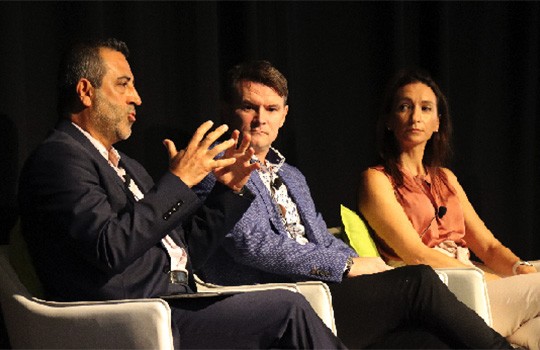
What does success look like at the end of the digital transformation rainbow? Why should incumbent insurers embrace, not fear, the insurtech surge? And what should insurers expect out of a collaborative, and fruitful, industry partnership – and why are they failing?
We take a look at some of the key insights shared during the Digital Leadership panel at FST’s Future of Insurance, 2020.
Featured panellists:
– Sami Yalavac, Chief Information Officer, Bupa
– Jamie Smith, Chief Information Officer, Hollard Insurance Company
– Rita Yates, Chief Executive Officer, Insurtech Australia
Moderated by Luke Hannan, MC.
————————————————
Moderator (Hannan): Let’s dive right in and start with opportunity. Where do you see the biggest opportunity for technology innovation to deliver value?
Smith: It’s definitely the customer experience, but more broadly than just customers of course. I think it’s experience across the entire value chain, whether you’re dealing with our customers, with our suppliers or with our internal users as well. Typically, the users within an organisation get lumbered with processes that are very inefficient in the backend and they try to make up for the customer experience with a lack of technology.
Yalavac: I can comment from the health insurance perspective. And health insurance is not just between the organisation and the customer – it’s the whole ecosystem. Because, at the end of the day, whatever you don’t manage well, leaves more pressure on the public system. We generally think about services as being limited: someone gets sick and we pay for it. Whereas we can play a role in navigating people towards better health outcomes; this means less pressure on the public system and less pressure on out of pocket costs for individuals, so there’s much bigger value if you play the role in a more responsible way rather than just thinking transactionally: “Someone will get sick, I’ll pay for it”, which is the core of insurance. But, actually, the real game-changer is how we’ll manage risk better and guide our customers – regardless of whether it’s in general insurance or health – so that you’re minimising the risk. And it’s a win/win for everybody, including the government, which is really struggling to fund the health system.
Yates: To Jamie’s point, there are tech propositions across all aspects of the insurance value chain, whether you’re looking at distribution or all the way down to the claim. There are players out there who are working on problems and pain points at every step of the way, essentially. So, from an individual organisation’s perspective, I think the real value comes from understanding where your pain points are, and then looking at what opportunities are there. And, also to Jamie’s point, my view on it is that when there is value to the customer, using a particular tech proposition, that’s where the real value comes into play: that might be value-added propositions, whole new products to market, or it might just be making the customer journey a lot more efficient and more delightful for the customer.
Smith: And I think it’s about doing that in a small bite-sized proof of value, along the value chain, rather than trying to solve an entire business problem end-to-end; that’s where you’re going to get big bang for buck.
Moderator (Hannan): Let’s keep going with new products – and we’ll talk about insurtech in a moment. What’s on the horizon and what small bites can you give us around what might be happening?
Yates: We’ve seen the insurtech ecosystem really boom over the last two years in Australia. And, as I said, rather than picking out one aspect of the value chain, what I can say is there are organisations working at every point along that journey. In terms of new propositions, they’re popping up all the time. We’ve grown from the initial point of membership, where we started out with a few companies in Australia that called themselves ‘insurtech organisations’ to – in quite a short space of time – now having a membership base of 64; and that’s growing month to month. So, there are real opportunities out there to be explored, and it’s just a matter of being educated as to what opportunities might be relevant to your organisation.
Smith: And there’s a fair bit of technology out there that’s looking for a business problem to solve and being involved with you guys is really helping connect those dots. So, there are a lot of things – if you try to do things yourself inside of an insurance company – that can actually be solved quicker, cheaper, faster by partnering with an insurtech – which is a bit different to a fintech, which, more often than not, is here to try to disrupt the industry.
Yates: Exactly. And, if you look at the figures, about 95 per cent of insurtech organisations are working as enablers as opposed to disruptors. This is very different to fintech, where a very big proportion of fintech organisations are looking to disrupt banking. So, if you take even just neobanks for example, they are looking to take customer share from existing banks.
Yalavac: I’ll not add too much more to that, but I think as both Rita and Jamie mentioned, the real game-changer is not just optimising what we do today, but in knowing the steps beyond that to create the bigger value chain. It requires greater collaboration, either within the industry itself – because we have the same challenges, we can easily collaborate, which I can’t say we’re doing a good job in so far – or in getting a broader vendor ecosystem, where they will not just throw us some toys and say “it’s your job to do something with that” compared with “this is the challenge in the industry, and how will we solve this together?”. I think this opportunity is the real game-changer here.
Moderator (Hannan): I want to talk about the difference between a fintech and insurtech, because that’s a really interesting proposition that fintechs are out there to take share away from the banks and, by taking $100s of millions in deposits, for example, that’s money that the bank has to fund. It’s fascinating then that insurtechs are here to add value as opposed to take share. What are some of the keys to success that you’ve seen – Rita, you mentioned you’ve moved from one or two members up to 64 today. What are some of the keys to success in partnering with an insurtech?
Yates: This is something that we discuss in our ecosystem very very regularly because, at the end of the day, it’s key to the ongoing success of our whole ecosystem, particularly if you look at the fact that 95 per cent of those insurtechs are looking to work with incumbents, it’s absolutely vital.
I guess the first thing is to understand that insurtechs and incumbents are completely different beasts, and just appreciating that fact. They’re not going to operate in the same way, so an awareness of that to start with is really important. Every partnership is different, but there are a few key fundamentals that come up time and time again, no matter the structure of the partnership you’re looking at. And those really start with very clearly defining ‘What is the problem that you’re trying to solve?’ as opposed to what we referred to before, which is just having tech that looks kind of fancy that you’re trying to find a spot for. So, starting with a problem, understanding very clearly what the potential solution is and the proposition that’s being put forward, what the desired outcome is and, in that process, what are the limitations on both sides on the incumbent and the insurtech side, and being very aware of that from the very beginning. That then leads to what we talked about around timeframes, setting very clear expectations and timeframes; so, if you have a good understanding of the problem, limitations, and outcome from the beginning, you hopefully will be able to provide a very quick “yes” or “no”, ‘this is going to work’ or ‘this is not going to work for this particular reason’, and then start conversations at that point. And that is very much appreciated from a start-up and scale-up perspective.
That then moves to making sure that, as an incoming organisation, you have a really good framework in place in your business, which is around fast-tracking processes, so what happens when you actually have the solution that you want to implement? What do you do next, and making sure that there is a framework in place? Part of that is actually having the right people understanding what that process is across the important parts of the business, which could include legal teams, IT, operations, procurement, and others that are relevant to the whole story. And then, lastly, understanding that iteration is going to be required and a test and learn environment is of utmost importance within your business. So, if you don’t currently operate under that sort of environment, how do you start building that in before even going down the path of trying to implement some of these new propositions?
Smith: You’ve beautifully described exactly the perfect storm. At Hollard, we’ve had some success either partnering with an insurtech to help distribute a product – we’ve been pretty good with Huddle in our partnership, where we’ve provided underwriting capacity – but we’ve also used insurtech inside our organisation to help take some friction out of some backend processes. One of the things we’re doing right now is going back and building that framework around ‘How do we better engage with an insurtech?’, ‘How do we accelerate, get the proof of value, be able to bypass or, at least, fast-track certain internal hurdles as an FSL organisation?’ It’s a challenge. And getting those into production quickly and, to some degree, to test and learn. And, if it doesn’t work, having a position to pull that down and move on and learn quickly.
Yalavac: One of the biggest challenges we face is that we’re not really equipped to work with these startups. We are not really equipped so well to innovate, because we are too busy and structured too much on what we do today: on the claims department, on the product, on sales etc, and it’s nobody’s job, really. And we really struggle both from the people’s perspective, in having that mindset and in the capability to explore these opportunities. But the real challenge is the culture itself: how to really explore this opportunity, how to engage them, and how to make them part of the journey so that we don’t miss these great opportunities. And while we call this ‘insurtech’, actually any technology organisation in a startup is a natural partner for us, because it might be a data-related initiative. They don’t call them insurtech- or insurance-related, but we desperately need that capability, maybe for a better claims management or better product design. And I see that in the market, not only in insurance but in most big organisations; big corporates are really struggling to engage them successfully and utilise them successfully. So this is about ‘Yes, we are governed well and everything has to be within certain rules and processes’, but how do you create that rule, give that flexibility, and not everything will have a positive ROE. But give us room for exploration of new ideas and accept that failure is part of the success journey and not a failure in itself. I think that’s the real show stopper and we still have to do a lot to overcome that challenge.
Moderator (Hannan): That dovetails really nicely into Rita’s ‘test and learn’ commentary as well: it’s not always going to make money, and you need to be prepared sometimes to throw it into the wall and if it sticks.
We’ll shift now to digital transformation. So, Sami, I’ll start with you on this one. You spoke about people and culture. What do you think digital transformation is going to do to the workforce?
Yalavac: Digital transformation might be all at the product level, which could introduce a new digital business model. This is one aspect. The other thing, you might be utilising your channels to serve the same service team business model. This is what most organisations do. It’s just channelling through a mobile app or web etc, but it’s the same. And the third part is the backend digitisation, which is the full automation of what’s happening behind the shiny web or shiny mobile application. And without getting all the pieces together, it will never be full end-to-end digitisation. If you come to the workforce, as you utilise technology, obviously it is replacing people doing manual work. And I read a quote recently which is particularly relevant: in the past, the workforce was with muscle, today it’s the brain, and in the future, it will be heart. Heart because, well, machines can probably think, but feeling beings can also think. And when you think about the customer experience we are talking about, this, at the end of the day, is not the transaction, but what people feel about that experience – and it’s no different for the employees either.
So, if you think what’s happening today, most roles are being replaced, and technology is doing the bulk of the work, and now you need a new workforce to be able to utilise technology, to be able to get value out of it, so the customer will get that and all corporates will get the final value really changing the skillset of that. The real job for us, it’s not a matter of what you know so far or what’s your experience, but can you learn? Or are we creating an organisation that can learn and have continuous learning rather than just static training? How will we make sure we’re given enough room so that people can learn and can utilise, because it’s easy to say that “we don’t have talent here, I’ll just go and buy from the market”. Well, firstly, we don’t have enough of them. And, secondly, you still need people loyal to your company, committed and with a significant business knowledge which you cannot ignore and you cannot win just by buying talent or by going to the big four, Deloitte etc. You have to make sure your current workforce is able to cope with that. And I think the organisation that will win in this game is the one that utilises the current workforce.
And the last thing I will say is that you still need new people and, regardless of your intentions, every year some in your workforce will retire. So, if you are here in 10 years, probably 30 per cent of your workforce will be retired, out of the industry – in other words, a new person will have a completely different mindset; how they look to work is not the same: they want to work part-time, they want to enjoy their life, they want to use the tools they want, they want flexibility, and our current corporate rules and policies are not equipped to deal with that. There is a big mismatch. Without engaging them successfully, you will not attract good people talent. I think it’s a big task for all of us to rethink the culture, the processes, how we use the technology to engage them. That’s the winning formula. If we ignore that, I believe the guts of the technology investment or whatever we’re doing will miss the game.
Smith: Tech is a sliver. It is an enabler of that, but it’s the ‘all change’ piece – that is much more important for our digital transformation journey. For us, to start with, it’s really about taking the robot out of the human. So, if a human does something more than four or five times, that’s a great case for digitisation. However, the empathy part, you’re never going to be able to get a bot to do that.
Yalavac: Absolutely.
Yates: I completely agree with that. And I think another thing that I feel really passionately about is that some insurers, incumbents, and brokers, in the future, really need to look outside of insurance when they’re hiring into their businesses. Having a real breadth of experience, knowledge, but also views, and bringing new and fresh ideas and fresh perspectives into the business is actually a really great way of shaking things up and challenging what is referred to as the ‘dominant logic’ in insurance as a whole: that “We’ve done things this way for 50 years, we’re just going to keep doing it this way” mentality. And, so, potentially bringing in people from industries that have already been disrupted and taking a whole, fresh approach and a fresh look at what’s happening in the business, I think it’s going to be even more important as we move into the future. And the other thing I would say is that, whereas traditionally insurers certainly experience many individuals that have very deep knowledge in a particular sector or particular area of insurance, those individuals will start to move into different verticals because they’ll have to and may have to upskill as well. So the example that’s used a lot is that actuaries will also need to be trained in data science in the future to really do their jobs very very effectively.
Moderator (Hannan): It’s also fascinating, I find, bringing in the talent and the people who’ve got alternate perspectives. Going to the app now, one of the questions I’m seeing: Are we really seeing innovation in the insurance category all or are we just unpicking inefficiencies we’ve created over the last 50 years?
Yalavac: That’s a really good question. Most organisations initiated a digital transformation program. And when you look at what they are doing, as the person asking the question, it’s just a catch-up exercise. It’s just like what we haven’t done in the last five years, eight years we’re just trying to catch up to the basic needs people looking for. And, nowadays, people are not comparing us against other insurance companies; they’re competing us against the best experience they have with the other industries. If you are a Bupa customer, you are not comparing us with Medibank’s customer or others’ customers, but when you go to hospital they are seeing: “Hang on a minute, I can check-in so easily with Qantas for my flight. Why can’t I check in to hospital that easily with my insurance product? It’s called the ‘unreasonable customer’. It’s people who expect the best of what they see in all other services and they want you to do the same thing for them. That’s the real transformation, if we can achieve it. Otherwise, yes, the person is right, it’s just a catch-up exercise.
Yates: I agree too – that’s really where we’re at. We’re not yet at the point of exceeding customer expectations so much; we’re still at the point of actually meeting them. And customer expectations have changed so much and so rapidly in the last 10 or even five years that I think the way that the insurance industry operates, it’s been hard to actually get to the point where we’re actually meeting customer expectations. For me, I actually became a claimant 16 days ago because a tree fell through the roof of our house. And, all of a sudden, I took my insurance and insurtech hat off and I was the customer. And to say I’ve had a less than desirable experience is probably an understatement, unfortunately. It’s not the case all the time, but in this situation, the hole is still in my roof and I have no transparency over where the process is at whatsoever and very little ability to make contact with my insurer –I won’t say who that is. But, for me, that really brought into stark reality the fact that I can track my Woolies order, I know exactly when my kids are at any point in time and how long they’ve been there, I know where my ride is coming to the minute, but I have no idea what is happening with my insurance claim!
Smith: Insurance has typically been underserviced by the tech industry and we’ve not had to really make any change to our systems, as in people, process, and technology are still the same to some degree as they were 20 or 30 years ago, we’ve only ever touched around the edges. Vivek [Bhatia] touched on this earlier this morning [during his keynote]: digital transformation, Part One, is putting the website up, being able to take a quote; but even that experience is dictated by the backend systems. I think now is the time where we’re catching up, we’re creating a more modern architecture, and that will then allow us to do some of those other things, especially around transparency, the ease of use, and then genuine omnichannel. ◙
————————————————
This is an edited extract from Digital Panel Discussion: Looking Beyond 2020 featured at the Future of Insurance, 2020 conference.





